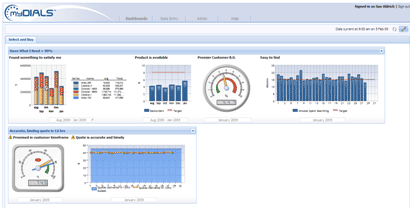What Belongs on Your Customer Dashboard?
Design Your Customer Dashboard to Monitor Performance on Customers' Moments of Truth
Everyone needs a Customer Dashboard, a set of KPIs to ensure that the company can optimize customer-impacting operations and maximize revenues. Everyone has excuses for why theirs isn't implemented yet. We’re bringing you a few steps closer, with a set of KPIs, a rationale, and a method.
VALUE OF A CUSTOMER DASHBOARD
An effective customer dashboard, with the right customer metrics, will tell you:
- Where you deliver value to customers
- How successful your customers are with your products and services
- Where you are failing to meet customer requirements
- Where operational problems are beginning to impact customer relationships
- Whether customers are increasing or decreasing their commitment to their relationship with your company
- Which segments are responding most positively to your current offers
- Whether there are new threats to your customer relationships looming
Do you have a customer dashboard? Do your operational executives have specific customer metrics that each of them tracks more or less daily? Most people will answer, “Yes! Well, sort of. Okay, not really, but we’re going to.”
Why Is It Hard to Deploy a Customer Dashboard?
We never cease to be amazed at the willingness of corporations to spend hundreds of thousands of dollars to count and track desks, chairs, and wall art, but balk at spending thousands to count and track their customers, their profit and revenue by customer, and the operational factors that affect customer behavior. It’s apparently worth significant sums every year to know whether employees are stealing chairs, but there is no value in knowing if competitors are stealing business from customers or if deteriorating service is driving customers away.
We can only blame habit. Accountants count assets, and their accounting standards apparently don’t tell them that customers are assets—or don’t provide models for how to do the counting. So the finance department continues to obsess on products, plant and equipment, and goodwill, and continues to ignore the most important customer-focused metrics. CFOs say, “Customer metrics belong to the Sales Department.” That’s true. But try telling a CFO that she shouldn’t be tracking product line profitability or production costs: “Ignore that stuff. It belongs to the Manufacturing Department.” Your advice would be considered exceedingly strange.
Every company we’ve worked with wants to know more about customers, the quality of the customer experience it is delivering, and how the company’s actions are affecting customers.
We help them determine what to measure to understand the current situation, the trends, and how to collect the data that will indicate and justify remedial actions. And then…a long pause ensues.
Here’s why those metrics take time to get implemented:
1. It requires IT attention, and there is no budget line for it this year.
2. Other executives are nervous that new metrics will disturb a status quo that they feel they finally have under control.
Item #2 above, the executive discomfort, can result in funds never becoming available for the metrics.
Good News: Implementation Is Getting Easier!
What makes the task easier is that dashboard products keep chipping away at the integration and presentation efforts. Today, it may be possible to get your customer dashboard with no more than a few days or hours of IT resource—plus some serious thinking about what belongs in it.
But Executive Buy-In Takes Longer
The best way to gain executive buy-in is to show your execs an example, using your own real customer data for your actual customers’ pain points. Your executives will see the cause and effect between operational customer metrics and financial results. They will realize that these customer-centric operational metrics are levers they can move, rather than customer survey data they can’t act upon.
Let’s instill some new counting habits, ones that will help you keep the customers you have, get more customers like them, and get more business from all of them. It’s important, and not nearly as hard as, say, replacing the customer relationships you’ve burned.
Detailed Customer Metrics: Select and Buy Tab

© 2009 Patricia Seybold Group Inc. and myDIALS, Inc.
Illustration 3. This section of a customer dashboard is based on our B2B Select and Buy Scenario Pattern. The tabs represent customer lifecycle stages. There is a row or panel for each moment of truth, two of which are shown here. The dials in the panel report company performance in delivering on those moments of truth. These and all other dials in the dashboard should enable drill down by customer segment, product line, geography, business unit, and other key financial and organizational differentiations.
World Class Companies Monitor and Improve What Matters Most to Customers
In 2001, in Patricia Seybold’s book, The Customer Revolution 1 , we published the results of a year-long study into the customer experience management approaches used by 13 companies on 3 continents in a variety of industries, ranging from mobile phones to financial services to industrial products. Each of these companies carefully monitors and improves their operational performance on the specific issues that matter most to their customers. Each of these firms also monitored the growth of their customer lifetime value and correlated it to customer experience. In The Customer Revolution, we used the metaphor of a Customer Flight Deck 2 to depict the kinds of customer experience metrics and customer value metrics these firms tracked.
Your Customers Will Show You What to Monitor
In our consulting practice, we help companies engage with their customers to co-design their ideal experiences and to identify their critical moments of truth. Customers are good at telling you how they measure success. As a part of each customer co-design session, we help clients develop Operational Scorecards 3 that link customers’ success metrics to the firm’s business processes and ROI. By starting with customers’ success metrics as your target, you can pinpoint the operational activities that you (or your business partners) need to monitor and improve in order to meet or exceed customers’ expectations.
Here’s an example...
Sign in to download the full article
0 comments
Be the first one to comment.



